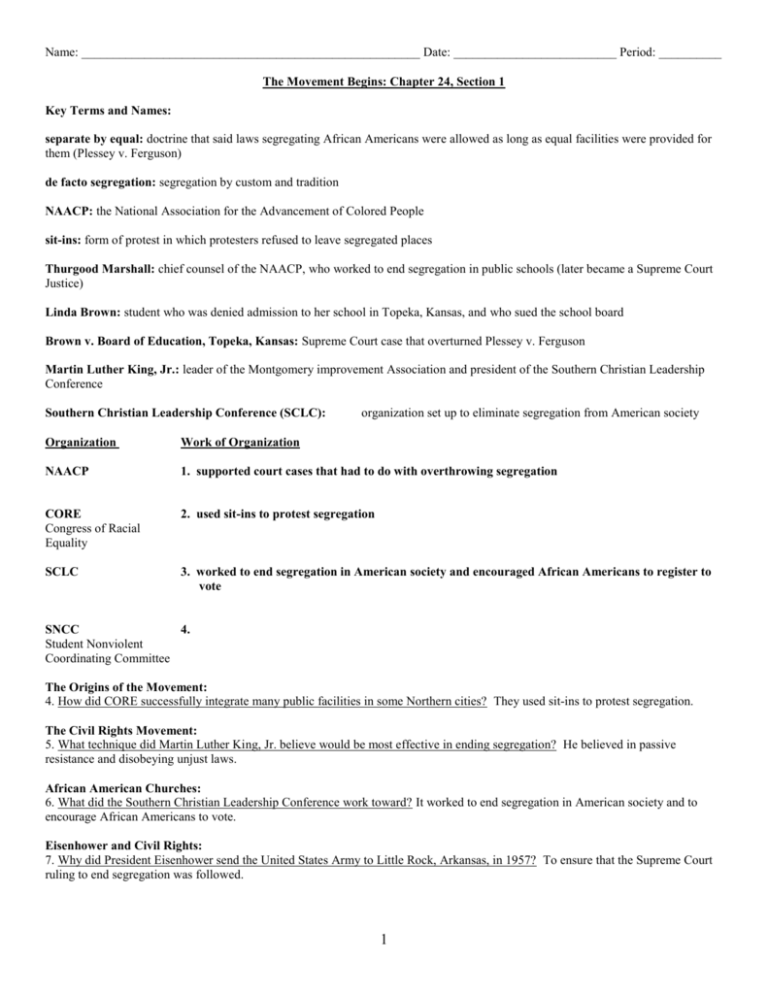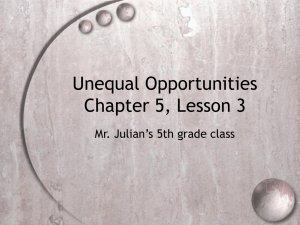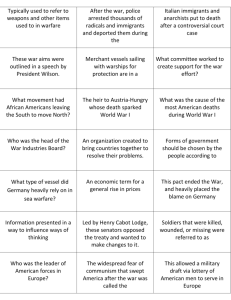KEY Chapter 24.doc
advertisement

Name: ______________________________________________________ Date: __________________________ Period: __________ The Movement Begins: Chapter 24, Section 1 Key Terms and Names: separate by equal: doctrine that said laws segregating African Americans were allowed as long as equal facilities were provided for them (Plessey v. Ferguson) de facto segregation: segregation by custom and tradition NAACP: the National Association for the Advancement of Colored People sit-ins: form of protest in which protesters refused to leave segregated places Thurgood Marshall: chief counsel of the NAACP, who worked to end segregation in public schools (later became a Supreme Court Justice) Linda Brown: student who was denied admission to her school in Topeka, Kansas, and who sued the school board Brown v. Board of Education, Topeka, Kansas: Supreme Court case that overturned Plessey v. Ferguson Martin Luther King, Jr.: leader of the Montgomery improvement Association and president of the Southern Christian Leadership Conference Southern Christian Leadership Conference (SCLC): organization set up to eliminate segregation from American society Organization Work of Organization NAACP 1. supported court cases that had to do with overthrowing segregation CORE Congress of Racial Equality 2. used sit-ins to protest segregation SCLC 3. worked to end segregation in American society and encouraged African Americans to register to vote SNCC 4. Student Nonviolent Coordinating Committee The Origins of the Movement: 4. How did CORE successfully integrate many public facilities in some Northern cities? They used sit-ins to protest segregation. The Civil Rights Movement: 5. What technique did Martin Luther King, Jr. believe would be most effective in ending segregation? He believed in passive resistance and disobeying unjust laws. African American Churches: 6. What did the Southern Christian Leadership Conference work toward? It worked to end segregation in American society and to encourage African Americans to vote. Eisenhower and Civil Rights: 7. Why did President Eisenhower send the United States Army to Little Rock, Arkansas, in 1957? To ensure that the Supreme Court ruling to end segregation was followed. 1 Challenging Segregation: Chapter 24, Section 2 Key Terms and Names: Jesse Jackson: student leader in the sit-in movement to end segregation Ella Baker: executive director of the SCLC who urged African American students to start their own organization (which they did— SNCC) Freedom Riders: teams of African Americans and white Americans who traveled through the South to draw attention to the South’s refusal to integrate bus terminals filibuster: a tactic in which senators take turns speaking and refuse to stop the debate and allow a bill to come to a vote cloture: a motion which cuts off debate and forces a vote Civil Rights Act of 1964: law that made segregation illegal in most public places poll tax: a fee that had to be paid in order to vote Kennedy’s Attempts to Support Civil Rights: 1. set up Committee on Equal Employment Opportunity to stop discrimination against African Americans by the federal government in hiring and promoting 2. ordered Interstate Commerce Commission to tighten regulations against segregated bus terminals 3. tried to push civil rights bill through Congress in 1963 The Sit-In Movement: 4. What group of people did the sit-in movement draw? It drew many African American college students. SNCC: 5. Where did the SNCC focus its efforts? To register African American voters in the rural areas of the South The Freedom Riders: 6. What was the goal of the Freedom Riders? To travel into the South to draw attention to the South’s segregation of bus terminals John F. Kennedy and Civil Rights: 7. Why was President Kennedy cautious about pushing for civil rights? He did not want to upset the Southern Democrats in Congress, whom he needed to pass some other bills. The Civil Rights Act of 1964: 8. Why did Martin Luther King, Jr. support a march on Washington, D.C.? he wanted to help get Kennedy’s civil rights bill passed by Congress. The Struggle for Voting Rights: 9. What was the purpose of the march from Selma to Montgomery? To keep pressure on the president and Congress to pass a voting rights bill. New Issues: Chapter 24, Section 3 Key Terms and Names: racism: prejudice or discrimination toward someone because of his or her race Chicago Movement: a plan by Martin Luther King, Jr. and other civil rights leaders to improve the economic conditions of African Americans in Chicago’s poor neighborhoods 2 Richard Daly: the mayor of Chicago black power: a movement that called for African American control of the social, political, and economic direction of the struggle for equality and stressed pride in the African American cultural group Stokely Carmichael: the leader of the SNCC in 1966 Malcolm X: the most visible spokesperson of the Black Power movement Black Panthers: a militant African American group that preached black power, black nationalism, and economic self-sufficiency Problems Facing Urban African Americans 1. African Americans faced discrimination in northern cities 2. African Americans held low-paying jobs 3. Half of African American families lived in poverty Kerner Commission Appointed to: Results of Kerner Commission: 6. study problems of poor, urban African Americans 7. no changes for African Americans 4. Many African Americans lived in dirty, overcrowded cities with high crime rates 5. Gains made by civil rights movement did not address African Americans’ social and economic problems Problems Facing Urban African Americans: 8. On what did the Kerner Commission blame the problems of the inner city? It blamed white society and racism. The Shift to Economic Rights: 9. Why were some civil rights leaders critical of King’s nonviolent strategies? They believed that the strategies did not improve economic conditions for African Americans. Black Power: 10. What did the Black Muslims believe African Americans should do regarding white society? They believed that African Americans should separate themselves from whites. The Assassination of Martin Luther King, Jr.: 11. What happened to the civil rights movement by the late 1960s? It was divided into competing organizations that were at odds with one another. 3








